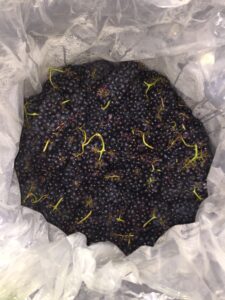Carbonic maceration describes a red winemaking whole bunch fermentation technique in which the first phase of fermentation is conducted in a completely anaerobic atmosphere, which transforms a small amount of malic acid and sugar in grapes to ethanol, along with traces of many flavourful aromatic compounds, without the intervention of yeasts. This occurs only if the grapes remain intact with absolutely no free grape juice, in a closed fermentation vessel filled with carbon dioxide. Other whole bunch fermentation techniques such as semi-carbonic maceration, or the inclusion in the fermenter of a percentage of whole bunches or whole berries as well as crushed grapes, result in some carbonic maceration occurring within the whole berries but with lesser amounts of the distinctive flavours in the wines.
Carbonic and semi-carbonic maceration are commonly applied to Gamay, Pinot Noir and Shiraz, to produce light-bodied, brightly coloured, elegant and perfumed or fruity wines, intended for early consumption, but the technique also has been used to help decrease naturally high levels of malic acid in wines, or as a blending component. Carbonic maceration wines have a distinctive aroma which often polarises tasters. The aromas can be described as ‘fruity’ or ‘musk-like’, with ‘strawberry/raspberry’ and ‘cherry/kirsch’ aromas (particularly in Beaujolais wines), but also with ‘vanilla’, ‘spice’, ‘almond’, ‘cinnamon’, ‘sandalwood’ or ‘oak-like’ characters. These characters often override any varietal fruit character, but conversely can also add aroma to wines with low varietal or fruit character.
APPLICATION AND HELPFUL HINTS
For a full carbonic maceration, intact whole bunches of grapes are placed in a closed fermentation vessel and an anaerobic atmosphere is created, generally obtained by using carbon dioxide to exclude oxygen. A modified version, patented by Stephen Hickinbotham in 1986, involves whole grape bunches placed in a plastic bag supported by a pallet box, into which a small quantity of dry ice in an insulated container has already been placed. The plastic bag is then sealed and sometimes fitted with a one-way valve to allow carbon dioxide to escape but to prevent entry of air. Under commercial winemaking conditions, it is almost impossible to produce a wine that depends wholly on carbonic maceration for the first phase of fermentation.
Carbon dioxide is absorbed by the grape berries, filling the berry to around 50% of its volume. This causes grapes to change from aerobic respiration to fermentative anaerobic metabolism. Intracellular fermentation takes place within the intact berry. More information on the chemical reactions occurring within the berry can be found in Ask the AWRI: Carbonic maceration. Carbonic maceration character and structure occur best if grapes are kept at temperatures around 30–32 °C for five to eight days. At lower temperatures over a period of up to three weeks, more subtle and short-term aromas are produced, but the intensity of the characters can vary depending on grape variety or wine style. To complete fermentation, the fruit is destemmed, crushed, and fermented with yeast under normal winemaking conditions, either with the skins or off the skins after pressing, but most commonly off the skins similar to a rosé style wine.
POTENTIAL RISKS
Risks of spoilage by acetic acid bacteria and Brettanomyces yeast are increased during carbonic maceration due to the higher pH, elevated temperatures and absence of sulfur dioxide. Additionally, if a carbon dioxide-rich environment is not adequately maintained, aerobic microorganisms can quickly take over, again causing wine spoilage.
RESOURCES
Casassa, L.F., Sari, S.E., Bolcato, E.A., Diaz-Sambueza, M.A., Catania, A.A., Fanzone, M.L., Raco, F., Barda, N. 2019. Chemical and sensory effects of cold soak, whole cluster fermentation, and stem additions in Pinot Noir wines. Am. J. Enol. Vitic. 70(1): 19-33.
Cowey, G. 2018. Ask the AWRI: Carbonic maceration Aust. N.Z. Grapegrower Winemaker (651): 70-71.
Ducruet, V. 1984. Comparison of the headspace volatiles of carbonic maceration and traditional wine. Lebensmittel-Wissenschaft & Technologie 17(4): 217-221.
Etaio, I. Elortondo, F. J. P. Albisu, M. Gaston, E. Ojeda, M. Schlich, P. 2008. Effect of winemaking process and addition of white grapes on the sensory and physicochemical characteristics of young red wines. Aust. J. Grape Wine Res. 14: 211-222.
Flanzy, C., Flanzy, M., Benard, P. 1987. La vinification par la maceration carbonique. Paris: INRA.
Sneyd, T. N. 1989. Carbonic maceration: an overview. Aust. N.Z. Wine Ind. J. 4(4): 281-282.
Tesniere, C., Flanzy, C., 2011. Carbonic maceration wines: characteristics and winemaking process. Jackson, R.S. (ed.) Advances in Food and Nutrition Research. 63: 1–15.

Figure 1. Carbonic maceration – grapes enclosed in a bag about to be filled with carbon dioxide

